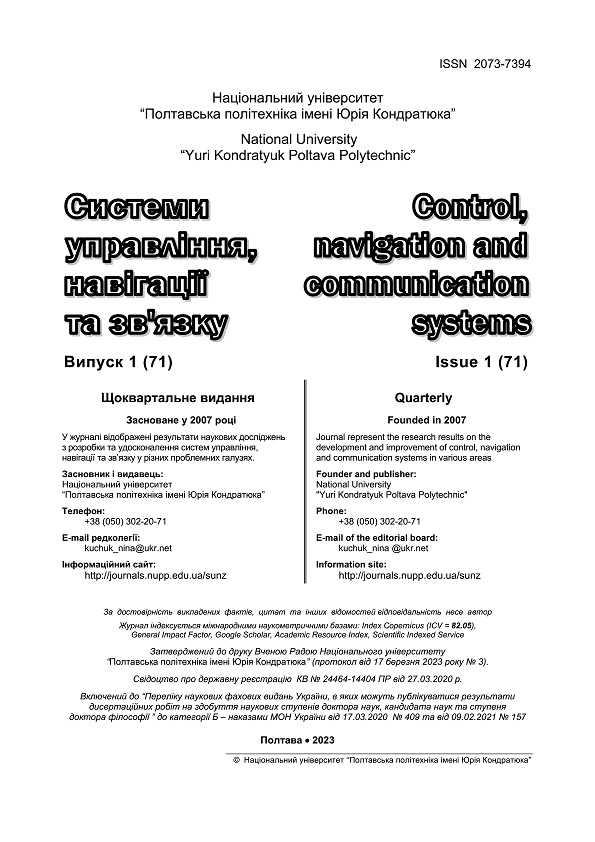DEVELOPMENT OF METHOD BASE ON FUZZY DECISION TREES FOR IDENTIFICATION OF THE COMPUTER SYSTEMS STATE
DOI:
https://doi.org/10.26906/SUNZ.2023.1.078Keywords:
computer system, state identification, data processing, machine learning, fuzzy logic, fuzzy decision treesAbstract
The subject of research is the methods and means of identifying the state of the computer system. The purpose of the article is to improve the quality of data classification by developing a method for identifying the state of the computer system. Task: to investigate methods of identifying the state of a computer system and to develop a method of classifying the state of a computer system for the purpose of data protection. Methods used: artificial intelligence methods, machine learning, decision tree methods. The following results were obtained: methods of identifying the state of the computer system KNN (k Nearest Neighbors), support vector method (SVM), neural networks, decision trees were investigated. The results were obtained: a method of identifying the state of the computer system based on of fuzzy decision trees, which differs from the known methods of fuzzy decision trees by the presence of a special procedure for falsification the attributes of source data and constructing membership function was proposed. The software was developed, in which the proposed method of solving the problem of identifying the state of the computer system was implemented and investigated. Conclusions. The scientific novelty of the obtained results lies in the study of methods for identifying the state of the computer system, the development of a method based on fuzzy decision trees, the assessment of the quality of the model at the stage of training and testing, and the performance of a comparative analysis.Downloads
References
О. Вдовенко. 25 мільйонів кібератак щомісяця. Як Росія намагається зашкодити Україні в цифровому просторі. URL: https://detector.media/infospace/article/204308/2022-10-29-25-milyoniv-kiberatak-shchomisyatsya-yak-rosiya-namagaietsyazashkodyty-ukraini-v-tsyfrovomu-prostori/.
S. Y. Gavrylenko & I. V. Sheverdin, “Development Of Method To Identify The Computer System State Based On The «Isolation Forest» Algorithm”. Radio Electronics, Computer Science, Control, 2021(1), pp. 105–116, doi:10.15588/1607-3274-2021-1-11
S.Y. Gavrylenko, V.V. Chelak and S.G. Semenov Development of Method for Identification the Computer System State based on the Decision Tree with Multi-Dimensional Nodes, Radio Electronics, Computer Science, Control (RECSC).– No. 2 (2022).– 2022.– pp.113-121, doi: 10.15588/1607-3274-2022-2-11.
Leon Reznik, "Computer Security with Artificial Intelligence, Machine Learning, and Data Science Combination," in Intelligent Security Systems: How Artificial Intelligence, Machine Learning and Data Science Work For and Against Computer Security , IEEE, 2022, pp.1-56, doi: 10.1002/9781119771579.ch1.
Amarudin, R. Ferdiana and Widyawan, "A Systematic Literature Review of Intrusion Detection System for Network Security: Research Trends, Datasets and Methods," 2020 4th International Conference on Informatics and Computational Sciences (ICICoS), 2020, pp. 1-6, doi: 10.1109/ICICoS51170.2020.9299068.
J. J. Davis and A. J. Clark, "Data preprocessing for anomaly based network intrusion detection: A review", Computers & security, 2011, vol. 30, no. 6-7, pp. 353-375, doi:10.1016/j.cose.2011.05.008.
J. Tai, I. Alsmadi, Y. Zhang and F. Qiao, "Machine Learning Methods for Anomaly Detection in Industrial Control Systems," 2020 IEEE International Conference on Big Data (Big Data), 2020, pp. 2333-2339, doi: 10.1109/BigData50022.2020.9378018.
S. Sun and R. Huang, "An adaptive k-nearest neighbor algorithm," 2010 Seventh International Conference on Fuzzy Systems and Knowledge Discovery, 2010, pp. 91-94, doi: 10.1109/FSKD.2010.5569740.
S. Malhotra, V. Bali and K. K. Paliwal, "Genetic programming and K-nearest neighbour classifier based intrusion detection model," 2017 7th International Conference on Cloud Computing, Data Science & Engineering - Confluence, 2017, pp. 42-46, doi: 10.1109/CONFLUENCE.2017.7943121
P. Gattineni and G. R. S. Dharan, "Intrusion Detection Mechanisms: SVM, random forest, and extreme learning machine (ELM)," 2021 Third International Conference on Inventive Research in Computing Applications (ICIRCA), 2021, pp. 273-276, doi: 10.1109/ICIRCA51532.2021.9544551.
L. Lin, R. Zuo, S. Yang and Z. Zhang, "SVM ensemble for anomaly detection based on rotation forest," 2012 Third International Conference on Intelligent Control and Information Processing, 2012, pp. 150-153, doi: 10.1109/ICICIP.2012.6391455.
M. I. Sayed, I. M. Sayem, S. Saha and A. Haque, "A Multi-Classifier for DDoS Attacks Using Stacking Ensemble Deep Neural Network," 2022 International Wireless Communications and Mobile Computing (IWCMC), 2022, pp. 1125-1130, doi: 10.1109/IWCMC55113.2022.9824189.
S. Gavrylenko, V. Chelak and O. Hornostal, "Research of Intelligent Data Analysis Methods for Identification of Computer System State," 2020 XXX International Scientific Symposium 'Metrology and Metrology Assurance (MMA), Sozopol, Bulgaria, 2020, pp. 1-5, doi: 10.1109/MMA49863.2020.9254252.
N. Kumar, H. Akash, R. A. Prataap, G. Srinath and C. Mala, "Intelligent Intrusion Detection System using Decision Tree Classifier and Bootstrap Aggregation," 2018 8th International Symposium on Embedded Computing and System Design (ISED), 2018, pp. 199-203, doi: 10.1109/ISED.2018.8704056.
J. Ye et al., "A Chi-MIC Based Adaptive Multi-Branch Decision Tree," in IEEE Access, vol. 9, pp. 78962-78972, 2021, doi: 10.1109/ACCESS.2021.3077125.
F. Q. Li, S. -L. Wang, A. W. -C. Liew, W. Ding and G. -S. Liu, "Large-Scale Malicious Software Classification With Fuzzified Features and Boosted Fuzzy Random Forest," in IEEE Transactions on Fuzzy Systems, vol. 29, no. 11, pp. 3205-3218, Nov.2021, doi: 10.1109/TFUZZ.2020.3016023.
S. Semenov, O. Sira , S. Gavrylenko, N. Kuchuk. Identification of the state of an object under conditions of fuzzy input data, EasternEuropean Journal of Enterprise Technologies, 2019, Vol 1, No 4 (97), pp.22-29, doi: 10.15587/1729-4061.2019.157085
Заде Л. Понятие лингвистической переменной и его применение к принятию приближенных решений, М.: Мир, 1976, 166 с.
Sumalatha and P. U. Sankar, "Fuzzy random decision tree (FRDT) framework for privacy preserving data mining," 2016 SAI Computing Conference (SAI), 2016, pp. 195-202, doi: 10.1109/SAI.2016.7555982.
and O. Hornostal, "Construction Method Of Fuzzy Decision Trees For Identification The Computer System State," 2022 XXXII International Scientific Symposium Metrology and Metrology Assurance (MMA), Sozopol, Bulgaria, 2022, pp. 1-5, doi:10.1109/MMA55579.2022.9992878




